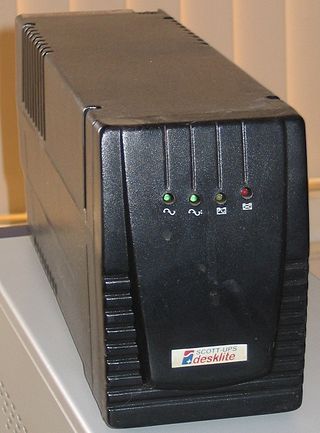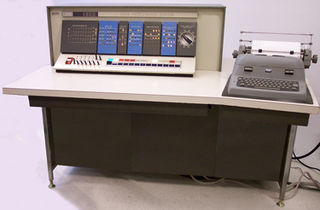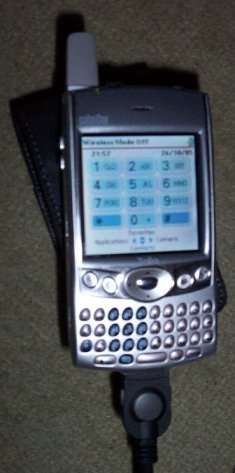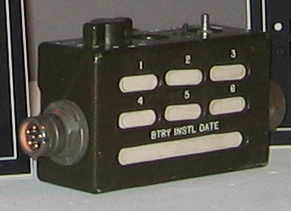In electrical engineering, a switch is an electrical component that can disconnect or connect the conducting path in an electrical circuit, interrupting the electric current or diverting it from one conductor to another. The most common type of switch is an electromechanical device consisting of one or more sets of movable electrical contacts connected to external circuits. When a pair of contacts is touching current can pass between them, while when the contacts are separated no current can flow.

In computing, booting is the process of starting a computer as initiated via hardware such as a button or by a software command. After it is switched on, a computer's central processing unit (CPU) has no software in its main memory, so some process must load software into memory before it can be executed. This may be done by hardware or firmware in the CPU, or by a separate processor in the computer system.

Communications security is the discipline of preventing unauthorized interceptors from accessing telecommunications in an intelligible form, while still delivering content to the intended recipients.

An uninterruptible power supply or uninterruptible power source (UPS) is an electrical apparatus that provides emergency power to a load when the input power source or mains power fails. A UPS differs from an auxiliary or emergency power system or standby generator in that it will provide near-instantaneous protection from input power interruptions, by supplying energy stored in batteries, supercapacitors, or flywheels. The on-battery run-time of most uninterruptible power sources is relatively short but sufficient to start a standby power source or properly shut down the protected equipment. It is a type of continual power system.

The IBM 1620 was announced by IBM on October 21, 1959, and marketed as an inexpensive scientific computer. After a total production of about two thousand machines, it was withdrawn on November 19, 1970. Modified versions of the 1620 were used as the CPU of the IBM 1710 and IBM 1720 Industrial Process Control Systems.

A power inverter, inverter or invertor is a power electronic device or circuitry that changes direct current (DC) to alternating current (AC). The resulting AC frequency obtained depends on the particular device employed. Inverters do the opposite of rectifiers which were originally large electromechanical devices converting AC to DC.
This is an index of articles relating to electronics and electricity or natural electricity and things that run on electricity and things that use or conduct electricity.

The Visual Memory Unit (VMU), also referred to as the Visual Memory System (VMS) in Japan and Europe, is the primary memory card produced by Sega for the Dreamcast home video game console. The device features a monochrome liquid crystal display (LCD), multiplayer gaming capability, second screen functionality, a real-time clock, file manager, built-in flash memory, and sound capability. Prior to the launch of the Dreamcast, a special Godzilla edition VMU, preloaded with a virtual pet game, was released on July 30, 1998, in Japan.
A DC-to-DC converter is an electronic circuit or electromechanical device that converts a source of direct current (DC) from one voltage level to another. It is a type of electric power converter. Power levels range from very low to very high.

Treo 600 was a smartphone developed by Handspring, and offered under the palmOne brand after the merger of the two companies. Released in November 2003, it has a number of integrated features and it is possible to check the calendar while talking on the phone, dial directly from contacts list, take pictures or send emails. It includes a five-way navigation button and favorites screen allowing quick access to the phone functions.
The National Security Agency took over responsibility for all U.S. Government encryption systems when it was formed in 1952. The technical details of most NSA-approved systems are still classified, but much more about its early systems have become known and its most modern systems share at least some features with commercial products.
The Electronic Key Management System (EKMS) is a United States National Security Agency led program responsible for Communications Security (COMSEC) key management, accounting, and distribution. Specifically, EKMS generates and distributes electronic key material for all NSA encryption system whose keys are loaded using standard fill devices, and directs the distribution of NSA produced key material. Additionally, EKMS performs account registration, privilege management, ordering, distribution, and accounting to direct the management and distribution of physical COMSEC material for the services. The common EKMS components and standards facilitate interoperability and commonality among the armed services and civilian agencies.

A security token is a peripheral device used to gain access to an electronically restricted resource. The token is used in addition to, or in place, of a password. It acts like an electronic key to access something. Examples of security tokens include wireless keycards used to open locked doors, or a banking token used as a digital authenticator for signing in to online banking, or signing a transaction such as a wire transfer.

TSEC/KY-68 DSVT, commonly known as Digital Subscriber Voice Terminal, is a US military ruggedized, full- or half-duplex tactical telephone system with a built-in encryption/decryption module for secure traffic.

A fill device or key loader is a module used to load cryptographic keys into electronic encryption machines. Fill devices are usually hand held and electronic ones are battery operated.

The AN/PYQ-10 Simple Key Loader (SKL) is a ruggedized, portable, hand-held fill device, for securely receiving, storing, and transferring data between compatible cryptographic and communications equipment. The SKL was designed and built by Ralph Osterhout and then sold to Sierra Nevada Corporation, with software developed by Science Applications International Corporation (SAIC) under the auspices of the United States Army. It is intended to supplement and eventually replace the AN/CYZ-10 Data Transfer Device (DTD). The PYQ-10 provides all the functions currently resident in the CYZ-10 and incorporates new features that provide streamlined management of COMSEC key, Electronic Protection (EP) data, and Signal Operating Instructions (SOI). Cryptographic functions are performed by an embedded KOV-21 card developed by the National Security Agency (NSA). The AN/PYQ-10 supports both the DS-101 and DS-102 interfaces, as well as the KSD-64 Crypto Ignition Key. The SKL is backward-compatible with existing End Cryptographic Units (ECU) and forward-compatible with future security equipment and systems, including NSA's Key Management Infrastructure.

The push-button telephone is a telephone that has buttons or keys for dialing a telephone number, in contrast to having a rotary dial as in earlier telephone instruments.
The IBM System/360 architecture is the model independent architecture for the entire S/360 line of mainframe computers, including but not limited to the instruction set architecture. The elements of the architecture are documented in the IBM System/360 Principles of Operation and the IBM System/360 I/O Interface Channel to Control Unit Original Equipment Manufacturers' Information manuals.
The KIK-30 "Really Simple Key loader" (RASKL) is a fill device made by Sypris Electronics and approved by the US National Security Agency for the distribution of NSA Type 1 cryptographic keys. It can also store and transfer related communications security material, including control data for frequency hopping radios, such as SINCGARS and Have Quick. It can store up to 40 cryptographic keys and has male and female U-229 connectors for the NSA DS-101 and 102 fill protocol, allowing it to be plugged into most other NSA fill devices and EKMS equipment. It is 6.14 inches long, weighs less than one pound and is powered by four AAA batteries. The operator interface has an 8 line of 20 characters and 6 buttons, with what Sypris calls "1-button key squirt" and 2-button zeroize.

NESTOR was a family of compatible, tactical, wideband secure voice systems developed by the U.S. National Security Agency and widely deployed during the Vietnam War through the late Cold War period of the 1980s. NESTOR consists of three systems. The KY-8 was used in vehicular and afloat applications; the KY-28 was the airborne version; and the KY-38 was the portable or man-pack model. About 30,000 NESTOR equipments were produced prior to their replacement by the VINSON secure voice family.














